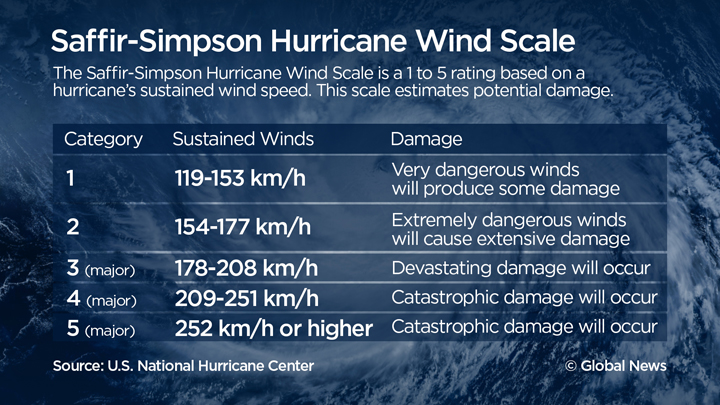The National Oceanic and Atmospheric Administration has released its annual Atlantic hurricane season forecast and is calling for a near-normal season.

Following on the heels of a relatively quiet 2015 Atlantic hurricane season, and a historical El Niño last winter, NOAA has called this forecast “challenging.”
READ MORE: U.S. to release 2016 Atlantic hurricane season forecast Friday
Though the Atlantic hurricane season is considered to run from June 1 to Nov. 30, Hurricane Alex formed in January, the first time a hurricane formed in that month since 1938.
Interestingly, as Friday’s predictions were released, there was a 90 per cent chance of a tropical storm forming in the Atlantic between Bermuda and the Bahamas.
NOAA is calling for a 45 per cent chance that the hurricane season will be near normal; a 30 per cent chance of an above-normal season and a 25 per cent chance that it will be below normal.
It’s important to note that NOAA’s predictions are probabilistic and not a guarantee, so the numbers they issue are stated as a likely range of activity.
For the Atlantic hurricane season, NOAA is predicting:
- 10–16 named storms, which includes Alex in January
- 4–8 hurricanes, which includes Alex in January
- 1–4 major hurricanes (Category 3 and above)
For each of these predictions, there is a 70 per cent probability.
WATCH: NASA captures stunning view of Hurricane Alex from space

“This is a more challenging hurricane season outlook than most because it’s difficult to determine whether there will be reinforcing or competing climate influences on tropical storm development,” said Gerry Bell, Ph.D., lead seasonal hurricane forecaster with NOAA’s Climate Prediction Center. “However, a near-normal prediction for this season suggests we could see more hurricane activity than we’ve seen in the last three years, which were below normal.”
NOAA uses the 1981–2010 period as an average, with 12 named storms, 6 hurricanes and 3 major hurricanes.
- 2021 heat dome fuelled by climate change, intensified wildfire risk: study
- B.C. introduces legislation recognizing Haida Gwaii Indigenous title
- Whale experts confident B.C. orca calf will survive, find family if rescue plan succeeds
- Chemical plant shuts down after high benzene levels detected near Ontario First Nation
The Saffir-Simpson scale
Our oceans go through phases of activity. Since 1995, the Atlantic was undergoing a warm phase called the Atlantic Multi-Decadal Oscillation (AMO), which was accompanied by warmer ocean temperatures, causing some uncertainty as to high hurricane activity. However, the Atlantic is now entering a cooler phase as well as a weaker West African monsoon, which could begin a time of low hurricane activity in the Atlantic.
Another influence is the dissipating El Niño, and a predicted strengthening of La Niña, a cooler phase in the Pacific which influences global weather patterns. The strength of the impending La Niña is uncertain, however.
The weather agency does not predict landfall ranges, as they tend to depend on daily weather patterns, which are impossible to predict so far in advance.
In August, NOAA will issue an updated outlook.







Comments